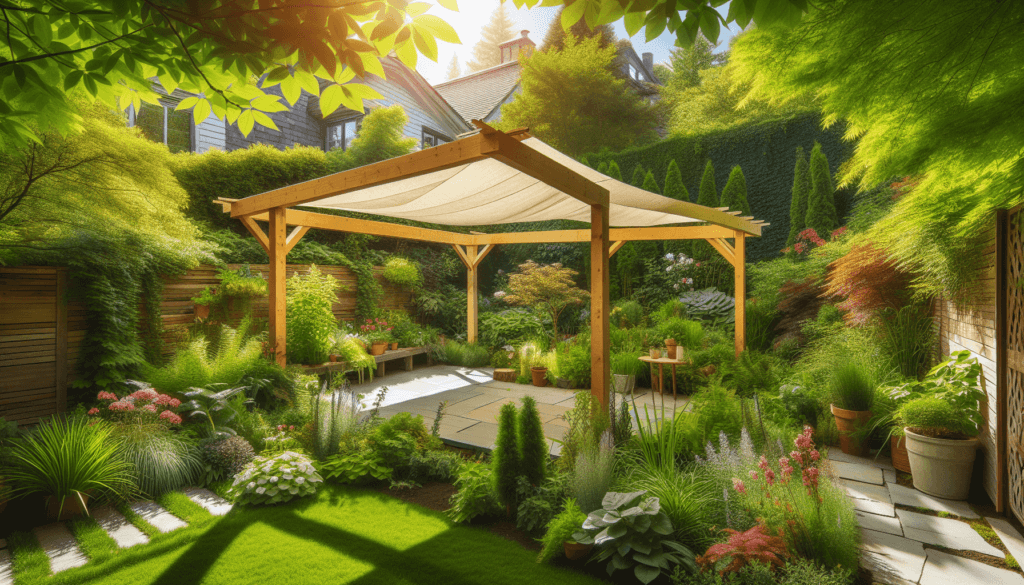If you’re looking to bring some relief from the blazing sun to your garden, then this DIY guide is just what you need. In this article, we’ll walk you through the step-by-step process of building your very own shade structure. Whether you’re a seasoned DIY enthusiast or a newbie with a hammer and nails, this guide is designed to help you create a beautiful and functional addition to your outdoor oasis. So grab your tools and let’s get started on creating the perfect shady spot for lounging, entertaining, and enjoying your garden to the fullest.
Choosing the Right Location
When it comes to building a shade structure for your garden, one of the first and most important steps is choosing the right location. Assessing the sunlight and shade patterns in your garden is crucial in determining where to place your shade structure. You want to make sure it provides adequate shade during the hottest parts of the day while still allowing some sunlight to filter through.
Additionally, it’s important to consider the proximity to other garden features. Will the shade structure obstruct any existing plants, paths, or seating areas? You want to make sure it enhances your garden and doesn’t disrupt the overall layout. Take some time to assess how the shade structure will fit into the existing design and choose a location that harmonizes with the overall aesthetic.
Lastly, examining soil composition and drainage is essential. You want to make sure the ground is stable and suitable for supporting the weight of the shade structure. Additionally, checking the soil’s drainage capabilities is important as you don’t want excess water pooling around the foundation. Consider the soil type in your garden and make any necessary amendments to ensure proper stability and drainage.
Selecting the Design
After choosing the right location for your shade structure, it’s time to move on to selecting the design. Determining the purpose and size of the shade structure is the first step in this process. Are you looking to create a small shaded area for relaxing or do you need a larger structure to cover a dining or entertaining space? Understanding the purpose and size will help guide you in choosing the right design.
Next, explore various types of shade structures available. Popular options include canopies, pergolas, and trellises. Each has its own benefits and features, so take the time to research and consider which design suits your needs and preferences. Additionally, think about the architectural style and aesthetics you want to achieve. You want your shade structure to complement the overall look and feel of your garden, so choose a design that harmonizes with your existing landscape and architecture.

Gathering Materials and Tools
Before you can start building your shade structure, you’ll need to gather the necessary materials and tools. Create a materials checklist to ensure you have everything you need. The specific materials will depend on the design you choose, but common items include wood, metal, fabric, and fasteners. Researching the best materials for durability and weather resistance is also crucial. You want your shade structure to withstand various weather conditions and last for years to come, so invest in high-quality materials that are built to last.
Identifying the necessary tools and equipment is equally important. Basic tools such as a drill, saw, measuring tape, and level will be essential, as well as any specialized tools that may be required for your specific design. Make sure you have all the tools needed before you start construction to avoid any delays or frustrations along the way.
Preparing the Site
Now that you have your materials and tools ready, it’s time to prepare the site where your shade structure will be built. Clear the area of debris and vegetation to ensure a clean and level working space. Remove any rocks, branches, or other obstructions that may interfere with the construction process.
Leveling the ground is the next step. Use a shovel, rake, or a level to even out the surface. This will ensure a stable foundation for your shade structure and provide a level base for construction. Take your time with this step to ensure accuracy and stability.
Depending on the soil composition, you may need to make any necessary soil amendments. This could include adding organic matter or nutrients to improve the quality of the soil or making adjustments for proper drainage. Assess your specific soil conditions and make the necessary amendments to create an optimal environment for your shade structure.

Building the Foundation
The foundation is a crucial element of any shade structure, as it provides stability and support. The type of foundation you choose will depend on your design and personal preference. Common options include concrete, gravel, or pavers.
If you decide to go with a concrete foundation, start by excavating and preparing the foundation area. Dig a hole of the appropriate size and depth and ensure it is level and squared. Install any necessary forms or reinforcements to ensure the concrete sets properly.
If you opt for a gravel or paver base, you’ll also need to excavate and prepare the foundation area. Remove the necessary amount of soil to accommodate the base material of your choice. Ensure the area is level and compact the soil to provide a stable surface. Install a layer of gravel or pavers, making sure they are properly leveled and compacted to create a solid foundation.
Constructing the Support Structure
Once the foundation is in place, it’s time to construct the support structure for your shade elements. Start by choosing the appropriate materials for the support posts. Wood is a popular option due to its versatility and aesthetic appeal, but metal or composite materials can also be used depending on your design preferences.
Measure and mark the locations for the posts according to your design plans. Use a measuring tape and level to ensure accuracy and consistency. Once the locations are marked, dig post holes of the appropriate size and depth. Make sure the holes are deep enough to provide stability and secure the posts firmly into the ground.
After digging the post holes, it’s time to set the posts securely. Place the posts in the holes and use a level to ensure they are straight and upright. Backfill the holes with soil, packing it firmly around the posts to provide stability. Consider adding concrete or a gravel mix around the base of the posts for additional support if needed.

Installing the Shade Elements
With the support structure in place, it’s time to install the shade elements of your structure. Determine the type of shade material you will be using, whether it’s a canopy, a pergola, or a trellis. This will depend on your design and the level of shade and privacy you desire.
Cut the shade material to the appropriate size and attach it to the support structure according to your design plans. Make sure to secure it properly to ensure it stays in place and provides the desired shade coverage. Consider adding any necessary reinforcements such as additional straps or brackets to enhance stability and durability.
Adding Finishing Touches
Once the main structure is complete, it’s time to add some finishing touches to enhance the aesthetics and functionality of your shade structure. Apply a protective finish or stain to the shade structure to protect it from the elements and prolong its lifespan. Choose a finish that complements the overall style of your garden and provides long-lasting protection.
Additionally, consider adding decorative elements or accents to enhance the aesthetics of your shade structure. This could include hanging plants, string lights, or decorative fabric draping. Let your creativity shine and personalize the structure to truly make it your own.
Lastly, ensure proper drainage and rainwater management. Make sure your shade structure has adequate drainage to prevent water from pooling and causing damage. This can be achieved through proper design and installation, as well as adding gutters or other drainage systems if necessary.

Maintaining the Shade Structure
Once your shade structure is complete, it’s important to maintain it regularly to ensure its longevity and functionality. Regularly inspect the structure for any signs of damage or wear. Look for any loose or broken components and address them promptly to prevent further damage.
Cleaning and removing debris from the shade material is also important. Leaves, dirt, and other debris can accumulate and cause damage or deterioration over time. Regularly sweep or hose down the shade material to keep it clean and free from debris.
Lastly, perform any necessary repairs or replacements as needed. Address any issues promptly to prevent them from worsening and compromising the integrity of the structure. Stay proactive in maintaining your shade structure to enjoy its benefits for years to come.
Conclusion
In conclusion, building a shade structure for your garden can be a rewarding DIY project that enhances the functionality and aesthetics of your outdoor space. By following the steps outlined in this guide, you can choose the right location, select a design that suits your needs, gather the necessary materials and tools, prepare the site, build a solid foundation and support structure, install the shade elements, add finishing touches, and maintain the structure for long-term enjoyment.
Building a shade structure provides numerous benefits, including protection from the sun’s rays, the creation of a comfortable outdoor living space, and the enhancement of your garden’s overall beauty. So, why wait? Start planning and building your shade structure today and enjoy the many benefits it will bring to your garden and outdoor lifestyle. Happy building!



